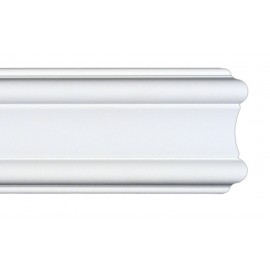No products
Casings & Chair Rail
- Bath
- Decorative Wood
- Flooring
- Furniture
- Kitchen
- Moldings
- Outdoor
- Stair Parts
-

Bona Pro Series Stone, Tile and Laminate Floor Cleaner - 32 oz. - WM700051188
Professional strength to clean all...
$12.49 $12.49
Casings & Chair Rail There are 44 products.
Subcategories
Gold Foiled
For anyone looking for an elegant way to adorn your home or business, our gold foil products are the perfect way to achieve your desired look. Made out of polyurethane and then coated with 18k gold foil, these products are sure to leave your family and clients impressed.Quick Facts: Made from wood/ceramic or polyurethane Coated in 18k gold foil Durable and longlasting Easy to installPrimed White
A chair-rail molding divides wall horizontally, usually about three feet above the floor. Chair-rail was originally designed to prevent the tops of the chair backs from denting or marring the walls. For this reason chair-rail molding traditionally located about 30 to 33 inches above the floor and wrap around the perimeter of the room. Chair rail molding and frieze molding are horizontal wall moldings have been popular features of many architectural styles. This moldings have a very interesting origins and styles. Chair rail molding, also called dado rail, is installed about waist high. Chair rail molding originally was used to protect walls from chair backs. Today, chair rail molding is a common detail in traditional interiors. Considered decorative by today's standards, chair-rail molding adds a feeling of detail and charm to the walls and lends continuality to a room by unifying it Chair rail provides a focal point offering a beautiful decorating effect. Chair rail molding unifies various architectural details in the room, such as door and window trim, fireplace mantels etc. Chair rails often serve as a cap for wainscoting. Picture rail molding and frieze molding have a similar visual effect as a chair rail molding.Wooden
Chair rails are used approximately 30' to 40' from the floor, running horizontally to form a "wainscot" look. They can also be used as panel mouldings to form panels on walls or ceilings.
DM-8014 Flat Molding
DM-8014 Flat Molding 7¾" Height 1½" Width 96" Length Delivery Time: 3 to 7 Business DaysColor: White PrimerMaterial: Polyurethane
$59.99In StockDM-8034 Flat Molding
DM-8034 Flat Molding 3⅝" Height 1⅜" Width 96" Length Delivery Time: 3 to 7 Business DaysColor: White PrimerMaterial: Polyurethane
$37.49In StockFM-5505 Flat Molding
FM-5505 Flat Molding 3½" Height 1" Width 94½" Length Delivery Time: 3 to 7 Business DaysColor: White PrimerMaterial: Polyurethane
$18.74In StockFM-5512 Flat Molding
FM-5512 Flat Molding 5" Height 1½" Width 96" Length Delivery Time: 3 to 7 Business DaysColor: White PrimerMaterial: Polyurethane
$43.74In StockFM-5518 Flat Molding
FM-5518 Flat Molding 4¾" Height ½" Width 96" Length Delivery Time: 3 to 7 Business DaysColor: White PrimerMaterial: Polyurethane
$31.23In StockFM-5551 Flat Molding
FM-5551 Flat Molding 7" Height 1" Width 96" Length Delivery Time: 3 to 7 Business Days Color: White Primer Material: Polyurethane
$69.85In StockFM-5707 Flat Molding
FM-5707 Flat Molding 4¼" Height ¾" Width 94½" Length Delivery Time: 3 to 7 Business DaysColor: White PrimerMaterial: Polyurethane
$31.23In StockFM-5720 Flat Molding
FM-5720 Flat Molding 3⅛" Height ⅞" Width 96" Length Delivery Time: 3 to 7 Business DaysColor: White PrimerMaterial: Polyurethane
$18.74In StockFM-5726 Flat Molding
FM-5726 Flat Molding 3⅛" Height ¾" Width 96" Length Delivery Time: 3 to 7 Business DaysColor: White PrimerMaterial: Polyurethane
$18.74In StockFM-7000 Flat Molding
FM-7000 Flat Molding 3½" Height ¾" Width 96" Length Delivery Time: 3 to 7 Business DaysColor: White PrimerMaterial: Polyurethane
$22.49In StockFM-7215 Flat Molding
FM-7215 Flat Molding 3½" Height 1" Width 96" Length Delivery Time: 3 to 7 Business DaysColor: White PrimerMaterial: Polyurethane
$24.99In StockWR-9093 Ceiling Relief Set
WR-9093 Ceiling Relief Set 3" Height 1¼" Width 94½" Length Delivery Time: 3 to 7 Business DaysColor: White PrimerMaterial: Polyurethane
$24.99In Stock


























